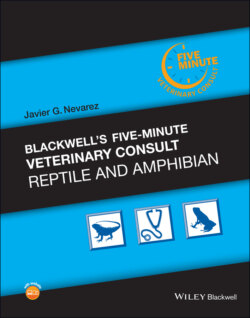Читать книгу Blackwell's Five-Minute Veterinary Consult: Reptile and Amphibian - Javier G. Nevarez - Страница 197
Оглавление
Hepatic Lipidosis
BASICS
DEFINITION/OVERVIEW
Hepatic lipidosis is the excessive accumulation of triglycerides in the hepatocytes and can result in altered hepatic function. It is expected to be a reversible lesion if the underlying cause is corrected. It is a common lesion diagnosed in reptiles.
ETIOLOGY/PATHOPHYSIOLOGY
Triglyceride accumulation in hepatocytes can occur due to disturbances of lipid metabolism from primary metabolic liver disease, toxins, protein malnutrition, diabetes mellitus, obesity, anorexia (increased fatty acid mobilization from peripheral stores), extrahepatic visceral inflammation, and anoxia (inhibits fatty acid oxidation).
In female reptiles, the change can be associated with folliculogenesis.
The common factor for each of these possible etiologies is a negative balance between the rates of deposition and dispersal of fat from the liver, resulting in an accumulation of triglycerides in the liver.
In reptiles, obesity from rich diets can result in hepatic lipidosis and enlargement of the coelomic fat bodies.
Reduced activity will also contribute to increased fat deposits and is not uncommonly reported condition in monitors and turtles.
In tortoises, a lack of normal hibernation and reproductive activity can lead to hepatic lipidosis.
SIGNALMENT/HISTORY
Hepatic lipidosis is reported to be more common in turtles. Data from one laboratory (D Reavill, unpublished) found the percentages of hepatic lipidosis in the reptile groups with the liver submitted for evaluation, as follows:chelonians (turtles and tortoises) (97/676) 14%lizards (304/1485) 20%snakes (91/1672) 5.4%
There is a reported difference in tolerance to the condition, with turtles being more resistant to metabolic derangements.
CLINICAL PRESENTATION
The clinical signs are generally non‐specific.
Signs include weakness, depression, pale oral mucous membranes, and non‐specific neurologic signs.
Green to blue urates are reported, and clay‐like, tan, or watery feces may also be noted.
RISK FACTORS
Husbandry
Inappropriate diet and overfeeding, such as chelonians fed only canned dog food.
Chronic stress: inappropriate captive husbandry conditions (POTZ, cage size, feeding strategies).
Inactivity: restricted physical activity due to space or adequate stimulation.
Inappropriate support for reproduction
Inappropriate hibernation conditions
Anorexia/hyporexia: desert and sulcata tortoises that have failed to eat for more than 1 week.
Others
N/A
DIAGNOSIS
Although the presumptive diagnosis is based on history, clinical signs, laboratory data, and imaging, the definitive diagnosis is made by microscopic evaluation of a liver biopsy or necropsy examination.
DIFFERENTIAL DIAGNOSIS
Hepatic lipidosis needs to be distinguished from other causes of hepatomegaly.
Vascular congestion: underlying cardiovascular disease.
Toxins: mycotoxins, pesticides, heavy metals
Infectious diseases: herpesvirus, adenovirus, Salmonellaspp., mycobacteria, Gram‐ negative bacterial infections, abscesses/ granulomas, protozoa.
Tumor: lymphoma, hepatoma
DIAGNOSTICS
Imaging
Radiographs ± contrast, ultrasound, CT, and MRI.
There may an enlarged hepatic silhouette on radiography.
Ultrasound may reveal a brightly reflective, enlarged, rounded liver.
CT provides measurements of radiodensity of the liver.
CT values lower than 20 HU are compatible with hepatic lipidosis in red‐footed tortoises (Chelonoidis carbonaria).
Hematology and Biochemistry
Serum biochemistry: lack of species‐specific reference ranges make interpretation challenging.
In general, decreased plasma proteins; increased triglycerides, cholesterol, AST, and LDH; glucose and bile acid levels vary; blood is often noticeably lipemic.
PATHOLOGICAL FINDINGS
The gross appearance is of an enlarged, friable liver, pale tan to yellow, and typically has a greasy feel.
Biopsy and/or necropsy histopathology: the hepatocytes will be variably enlarged, and supporting cytoplasmic vacuolization with HE stain.
Additional stains will demonstrate the prominent oil red O‐positive lipid droplets in all the hepatocytes.
TREATMENT
APPROPRIATE HEALTH CARE
Administration of oral medications is recommended.
NUTRITIONAL SUPPORT
Placement of an esophagostomy tube for feeding is recommended.
Maintain at appropriate temperature and humidity; exercise.
Caloric reduction with a nutritionally complete, low‐fat, high‐quality protein, liquid diet (Lafeber’s Emeraid®, EmerAid, LLC, Cornell, IL; Oxbow Critical Care®, Oxbow Animal Health, Omaha, NE; or Oxbow Carnivore Care®, Oxbow Animal Health, Omaha, NE).
Hydration
CLIENT EDUCATION/HUSBANDRY RECOMMENDATIONS
N/A
MEDICATIONS
DRUG(S) OF CHOICE
Antibiotic of choice in reptiles if needed: ceftazidime.
Nutriceuticals such as silymarin and milk thistle are reported to be an anti‐ inflammatory and antioxidant; however, there are no studies to support claims for hepatic benefits.
PRECAUTIONS/INTERACTIONS
Avoid hepatotoxic agents in reptiles:
antibiotics: doxycycline, clindamycin, erythromycin
antivirals: acyclovir
antifungals: itraconazole, ketoconazole
antiparasitic: metronidazole, dichlorvos, tiabendazole, ivermectin
FOLLOW‐UP
PATIENT MONITORING
Regular checkups to assess body weight, change in serum biochemistries, and possibly rebiopsy.
EXPECTED COURSE AND PROGNOSIS
After support through any acute crisis, the long‐term prognosis depends on associated conditions and whether these can be changed.
MISCELLANEOUS
COMMENTS
N/A
ZOONOTIC POTENTIAL
N/A
SYNONYMS
Fatty liver
Vacuolar hepatopathy
ABBREVIATIONS
AST = aspartate aminotransferase
CT = computed tomography
HE = hematoxylin and eosin
LDH = lactate dehydrogenase
MRI = magnetic resonance imaging
POTZ = preferred optimal temperature zone
Suggested Reading
1 Divers SJ, Cooper JE. Reptile hepatic lipidosis. Semin Avian Exot Pet 2000;9(3):153–164.
2 Knotková Z, Dorrestein GM, Jekl V, et al. Fasting and postprandial serum bile acid concentrations in 10 healthy female red‐ eared terrapins (Trachemys scripta elegans). Vet Rec 2008;163(17):510–514.
3 Marchiori A, da Silva ICC, de Albuquerque Bonelli M, et al. Use of computed tomography for investigation of hepatic lipidosis in captive Chelonoidis carbonaria (spix, 1824). J Zoo Wildl Med 2015;46(2):320–324.
4 Martínez-Silvestre, A. Hepatic lipidosis in reptiles. Proc SEVC, October 2013, Barcelona, Spain.
5 West G. Endoscopic hepatic biopsy in Coahuilan box turtles, Terrapene coahuila. J Herpetol Med Surg 2001;11(2):28–29.
Author Drury R. Reavill, DVM, DABVP (Avian and Reptile & Amphibian Practice), DACVP
